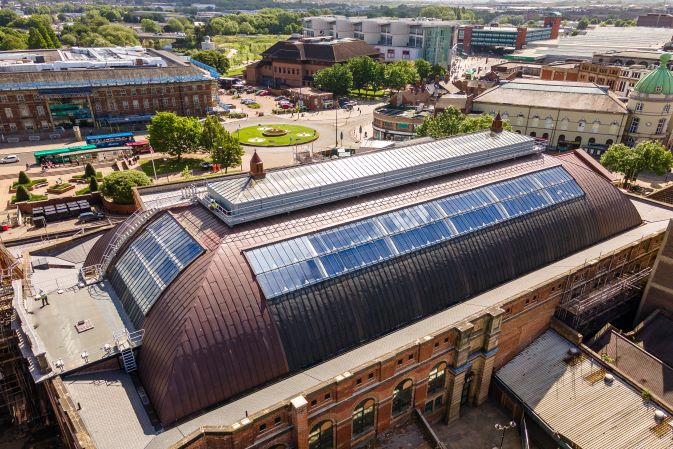The first phase of work to transform Derby’s historic Market Hall into an attractive retail and leisure destination fit for the future is now complete. Work is set to start soon on the second phase, which will focus on refurbishing the interior and developing the exterior public space at Osnabruck Square – a key entrance to the Grade II listed building.
Wates Construction, which has an extensive track record of heritage restoration projects around the UK, has been leading an expert project team of local architects and engineers on the flagship project, comprising Latham Architects, Rogers Leask, and Clancy Consultants.
The vision is to create a building that celebrates its heritage and market tradition, while offering attractive and flexible spaces that can be adapted to meet modern needs and evolving consumer demand.
A vibrant city centre
When it reopens, the Market Hall will include both traditional and themed markets, events, one-off or pop-up uses, make and trade spaces, and small performances – with a greater emphasis on food and drink to attract a wide range of businesses and visitors. Located at the heart of the city centre, linking Derbion and St Peter’s Quarter to the Cathedral Quarter and Becketwell, it will also play a key role in widening the diversity of the city centre economy.
A vibrant city centre is a key part of the strategy developed to ensure Derby’s economy remains resilient after the pandemic. A task force, made up of representatives from both public and private sectors, is driving activity to maintain business and investor confidence, diversify the local economy and decarbonise the city.
Councillor Mick Barker, Cabinet Member for Governance and Deputy Leader of Derby City Council, said:
Derby Market Hall is one of the city’s most beautiful and prominent buildings, which connects key areas of our city centre.
As a Grade II listed building, it deserves tasteful and sympathetic attention to detail to its renovation. Quality takes time and we’re delighted to see that this striking copper roof has now been finished, which paves the way for the rest of the Market Hall’s transformation.
Soon we can move onto the internal renovation and give Derby a fantastic market, which is full of life and which will help draw people back into the heart of our city.
After undergoing extensive roof and structural restoration assisted by a scaffolding structure weighing more than eight blue whales, the Grade II listed Victorian market hall, which has been trading since 1866, is well on its way to being transformed into a contemporary and vibrant cultural and retail destination.
The work completed included masonry repairs to the building envelope, internal cleaning of the roof structure, and removing lead paint before the challenging and extensive heritage glazed roof replacement works. This included increasing ridge height to accommodate natural ventilation for the building, copper roof replacement, gutter and rainwater works, access equipment, localised electric works, lightening protection, and decoration.
John Carlin, Regional Director at Wates Construction, said:
It has been a privilege to work on the restoration and transformation of such an iconic and unique building, maintaining its historic charm but also bringing it into the council’s overall modern vision for the revitalisation of the wider city centre.
Before this work on the roof was carried out, the Market Hall often had to close to customers for safety reasons if there was possibility of strong winds, snow, or heavy rain in case the glass windows came out of their frames. Along with the extensive restoration of the roof structure, all of these windows have now been replaced, meaning that closing the market and disrupting trade just for weather will no longer be necessary.
Making sure that trading could continue while initial surveys and work on the roof took place was particularly important. To do this, we installed a scaffolding structure to give access to the roof without disrupting ground level activity. It was an impressive feat of engineering all by itself, which would have spanned more than 62 miles if placed end-to-end and weighed almost 900 tonnes, but it really was the key to making sure trade could continue despite our ongoing work, supporting the city’s traders post-pandemic.
Throughout the process, the project team supported traders and the council project team to a high level, offering tours and site visits, as well as engaging with local sixth-form college students and a range of industry professionals to involve the local community in the project.
The team is now looking forward to starting the second phase of the transformation, which is due to start later this year. Raised concrete floor plinths that currently house individual market stalls will be removed to create a more airy, open and accessible space The ground level is intended to provide space for up to 32 market stalls, which will be portable for flexibility.
Meanwhile, the interior balcony area will provide an opportunity to accommodate a small business incubator, and to provide space for special themed markets, such as antiques or crafts. The entrances to the Market Hall are also set to be improved in the upcoming phase of work, allowing market activity to flow seamlessly into the surrounding streets and creating an attractive and flexible space in the adjacent Osnabruck Square.
